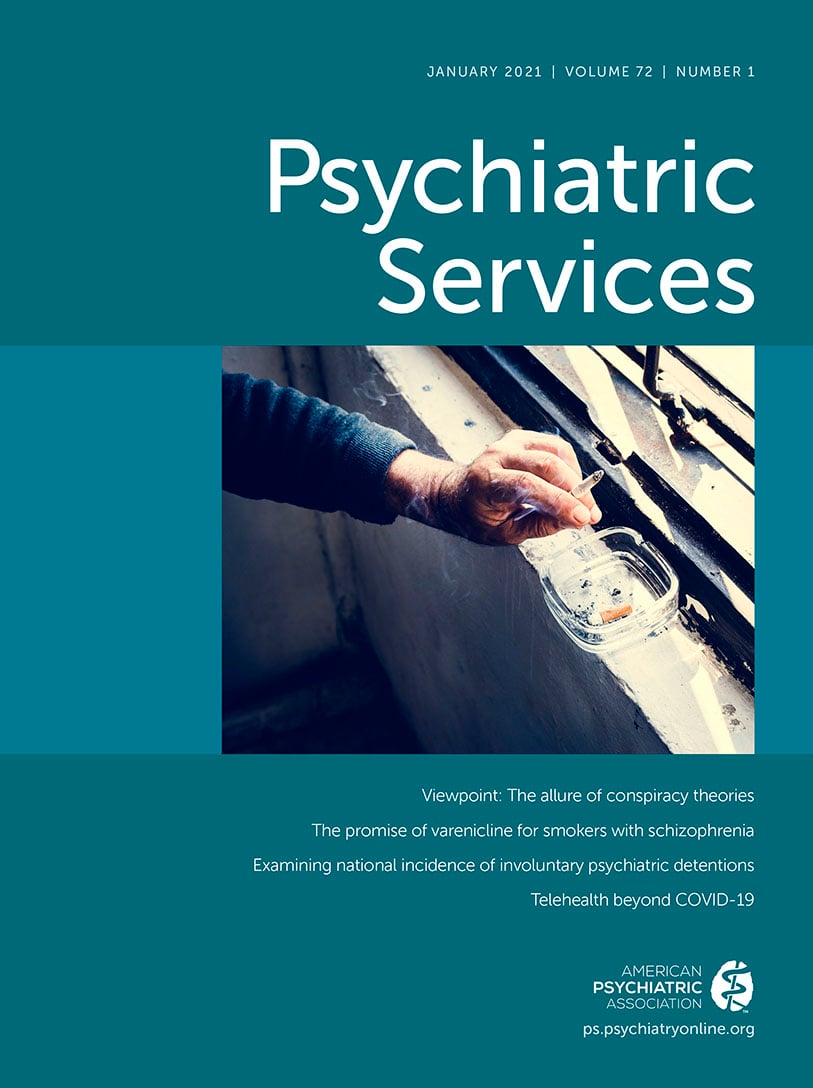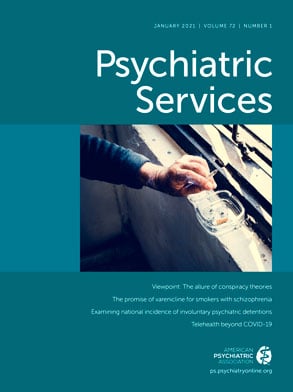In April 2016, the U.S. Food and Drug Administration (FDA) approved pimavanserin (Nuplazid, Acadia Pharmaceuticals) for the treatment of hallucinations and delusions associated with Parkinson's disease psychosis. After three unsuccessful trials (
1), pimavanserin was ultimately approved on the basis of a phase 3 placebo-controlled randomized trial, which showed that patients who received the drug reported, on average, a 3-point reduction on the Scale for the Assessment of Positive Symptoms for Parkinson's Disease Psychosis (
2). Postmarketing surveillance has raised concerns regarding the drug’s safety, but the FDA subsequently analyzed postmarketing data and concluded in September 2019 that the benefits of pimavanserin outweigh its risks. However, the analysis acknowledged that increased mortality in the elderly population could be similar to that seen for first-generation antipsychotic agents (
3).
Prior studies have shown an association between industry payments to physicians and physicians’ likelihood of prescribing biologics, gabapentin, and statins (
4,
5), and one study (
6) has demonstrated that physician payments increase the odds of physicians prescribing costly brand-name drugs of uncertain benefit. However, in contrast with the treatments analyzed in these studies, pimavanserin is a niche product with a history of questions regarding both its efficacy and safety (
7). No evidence exists about the influence of physician payments on prescribing patterns and Medicare expenditures for a drug that faces scrutiny for its real-world effectiveness and that has considerable safety issues. In this study, we quantified the association between industry payments to physicians for pimavanserin and both pimavanserin prescription volume and Medicare expenditures for its use. In contrast to prior work, we also examined how the associations of interest varied by the magnitude of industry payments.
Methods
This retrospective cross-sectional study used 2016 and 2017 data from the Centers for Medicare and Medicaid Services (CMS) Open Payments database and the CMS Part D Prescriber Public Use Files. Open Payments data contain information on financial payments made by drug and medical device companies to physicians and teaching hospitals. The Part D prescriber data provide information on physician specialties and drugs prescribed by physicians to Medicare beneficiaries who are enrolled in Part D. Unique national physician identifiers are not available in Part D prescriber data. Therefore, both data sets were linked by a unique physician identifier on the basis of the physician’s first name, last name, city, and state. We used Open Payments to analyze payments related to pimavanserin made by Acadia Pharmaceuticals to physicians for food, travel, lodging, speaking, consulting, and education. Part D prescriber data were used to quantify pimavanserin prescription volume and pimavanserin-related Medicare expenditures.
First, we calculated total payments received by physicians from Acadia Pharmaceuticals. Descriptive statistics, including total number, mean±SD, median, and interquartile range (IQR), were used to describe payments to physicians, pimavanserin prescription volume, and associated Medicare expenditures, overall and by physician specialty. We categorized physician specialty into three groups: neurologists, psychiatrists, and others. We grouped physicians on the basis of total payments they received and analyzed pimavanserin prescription volume and associated Medicare expenditures for each group. After exploring the distribution of payments to physicians, we categorized payments into five groups: $0; $1–$100; $101–$1,000; $1,001–$100,000; and >$100,000. We constructed Poisson regression models to quantify the association between physician payments and pimavanserin prescription volume by using three models that reflected total payments; payments for food, travel, and lodging; and payments for speaking, consulting, and education. We modeled the association between physician payments and Medicare expenditures for pimavanserin with linear regression, again by using three separate models for different types of payments. All analyses were conducted with SAS, version 9.4.
Results
In 2016 and 2017, 1,609 physicians ordered 43,165 pimavanserin prescriptions, incurring $82,376,713 in Medicare expenditures. Overall, 45% (N=726) of these physicians received payments, which totaled to $6,369,922 ($5,615,470 for speaking, consulting, and education and $754,452 for food, travel, and lodging); these physicians wrote 23,586 pimavanserin prescriptions and incurred $48,141,918 in Medicare expenses. Physicians receiving payments wrote 46% more prescriptions than those who received no payments (mean±SD=32±38 versus 22±19, p<0.001), and their total prescriptions were 71% more costly in Medicare expenditure ($66,311±79,336 versus $38,771±42,809, p<0.001). The manufacturer spent an average of $270 ($6,369,922/23,586) per prescription, which cost $2,014 ($48,141,918/23,586) per prescription in Medicare expenses.
Overall, 55% of physicians received no payments, 22% received $1–$100, and 7% received more than $1,000 (
Table 1). Of physicians who received $1–$1,000, nearly 100% ($68,327/$68,357) of the money from these payments was for food, travel, and lodging. In contrast, of those who received more than $1,000, 89% ($5,615,440/$6,301,565) of the money from these payments was for speaking, consulting, and education (see
online supplement). Higher physician payments were associated with a greater volume of pimavanserin prescriptions. Physicians receiving no payments wrote a median of 16 (IQR=12–24) prescriptions, whereas those receiving $100,000 or more wrote a median of 96 (IQR=51–187) prescriptions. Likewise, higher physician payments were associated with greater Medicare expenditures for use of pimavanserin. For example, physicians with no payments accounted for a median Medicare expenditure of $26,817 (IQR=18,719–41,273), whereas those with payments exceeding $100,000 accounted for expenditures of $201,793 (IQR=100,097–422,267).
Half (N=809) of the physicians who prescribed pimavanserin were neurologists, 7% (N=108) were psychiatrists, and the remaining physicians had other specialties (N=692, 43%) (see online supplement). Of total payments, neurologists received $4,764,689 (75%), psychiatrists received $1,462,615 (23%), and those with other specialties received $142,618 (2%). Psychiatrists received higher payments than neurologists ($13,543±$35,722 versus $5,890±$22,039, p=0.03). Pimavanserin prescription volume was similar between psychiatrists and neurologists (25±41 versus 31±34, p=0.19) but was less costly for psychiatrists than neurologists in terms of Medicare expenditure ($48,530±$76,646 versus $69,189±$73,684, p=0.006).
Poisson regression analysis revealed that every $10,000 of physician payments was associated with a 14% increase in pimavanserin prescription volume (incident rate ratio [IRR]=1.14, 95% confidence interval [CI]=1.13–1.14). The linear regression model showed that every $100 spent by the manufacturer on physician payments was associated with a $175.84 increase in pimavanserin-related Medicare expenditures (95% CI=$161.55–$190.13). Food, travel, and lodging payments had a greater association with pimavanserin prescription volume (IRR=2.27, 95% CI=2.27–11.36) and Medicare expenditures ($1,135.88, 95% CI=$1,023.83–$1,247.93) than did speaking, consulting, and education payments (prescribing, IRR=1.16, 95%=CI 1.16–1.16; Medicare expenditures, $201.55, 95% CI=$185.33–$217.77).
Discussion
Our study adds to growing evidence of the association between pharmaceutical industry payments to physicians and physician prescribing. However, in contrast to prior work, we focused on a product that is not commonly used and that has a history of uncertainty regarding both its efficacy and safety (
7). Interestingly, the 45% of physicians who received payments from pimavanserin’s manufacturer accounted for more than half (55%) of all pimavanserin prescriptions. Psychiatrists received higher average payments by Acadia Pharmaceuticals than did neurologists but accounted for lower Medicare expenditures for pimavanserin. Higher payments were associated with increased pimavanserin prescription volume and increased Medicare expenditures.
In 2016, pharmaceutical companies paid $261.11 million (27% of all nonresearch payments) to physicians for food, travel, and lodging (
8). In our study, food, travel, and lodging payments accounted for about one-tenth ($754,452/$6,369,922, 12%) of total payments made to physicians. However, these payments were more strongly associated with pimavanserin prescription volume and Medicare expenditures than were speaking, consulting, and educational payments. A prior study that evaluated the association between payments to physicians and prescribing of biologics produced similar findings (
4). In another analysis, physicians who received industry-sponsored meals, valued even as low as $20, were more likely to prescribe brand-name medication to Medicare patients than equally effective cheaper generic medications (
9), suggesting a potential association between small gifts or financial incentives and physicians’ prescribing practices (
10). Even a small gift can create a mindset of entitlement and influence a physician’s behavior to promote company products (
11). However, our study was not designed to evaluate the clinical appropriateness of pimavanserin use nor the motives of those who may continue to prescribe it.
Physician payments comprise a very small portion of medical marketing in the United States (
8). For example, in 2016, pharmaceutical companies spent an estimated $20.3 billion on direct marketing to health care professionals, while less than $1 billion ($979 million) was spent on direct physician payments, such as meal, travel, and speaking payments. Nearly three-fourths ($13.5 billion) of the expenditures were attributable to the retail value of free samples. A national survey of physician practices delivering primary care found that nearly 60% were accepting free samples (
12). Free samples are a highly effective marketing tool because they decrease the time needed to evaluate and potentially adopt a new product, and physicians and patients are more likely to continue the drug they received as a sample. Thus, although our findings suggest an association between payments to physicians and prescribing, our analysis does not capture the potential impact of other methods of marketing and promotion, such as the use of free samples.
Consulting and speaking fees paid to physicians may have been associated with pimavanserin prescription volume for several reasons. Physicians receiving industry payments are often content experts or key opinion leaders; in this study, physicians may have been selected on the basis of their experience treating Parkinson’s disease. These prescribers also may have participated in clinical trials of the product or have otherwise interacted with pharmaceutical company representatives. Interestingly, the association between receiving speaking, consulting, and education payments and pimavanserin prescription volume was lower than that of receiving food, travel, and lodging payments.
Our study had several limitations. First, it was a cross-sectional analysis, and the associations reported cannot not be interpreted as causal effect. Second, Medicare prescription for pimavanserin represents a subset of all pimavanserin prescriptions. Medicare Part D prescribing data do not capture prescribing information about patients who are not enrolled in Medicare Part D and therefore may not reflect a physician’s entire prescribing practice. Third, we used only 2 years of data in this study. Pimavanserin was approved in April 2016. Open Payments data are available for 2018, but Part D data are not. Newer data may provide further insights into trends in payments to physicians and pimavanserin prescribing practices. Fourth, Open Payments data do not capture certain physician payments or other transfers of value, such as product samples and educational materials intended for patient use.

